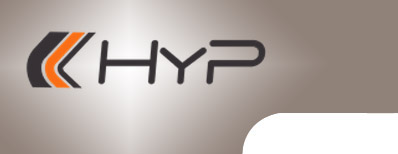MOUNTING OF HYDRAULIC HOSES |
The service life and reliable use of the hydraulic connection is decisively dependent on correct installation.
The hydraulic connection must be installed in such a way that: |
• the required length was maintained, which avoids longitudinal kinks and tensile load of the hose during operation;
bending radius should not be less than recommended;
• kinking of the hose, for example due to blockage of the swivel, must be limited to a minimum;
• the hydraulic connection must be located or protected in such a way that abrasion of the outer layer is minimal;
• the hydraulic connection must be properly secured if its weight could lead to an unacceptable load;
• if a defect in the hose line causes the danger of the hose blowing out, then it should be restrained or protected by a screen;
• if a defect in the hose line causes a risk of a pressurized medium escaping, the hose must be shielded. |
ERRORS IN MOUNTING HOSES |
• TORSION |
When installed in a twisted form, due to the friction of the layers against each other, the service life of the hydraulic connection is significantly reduced. Pressure carrier layers subjected to impulsive pressure tend to return to their neutral starting position. In this case, a special load occurs in the connection area.
Use the following as a guideline: A 7 degree twist reduces hydraulic hose life by 80%. |
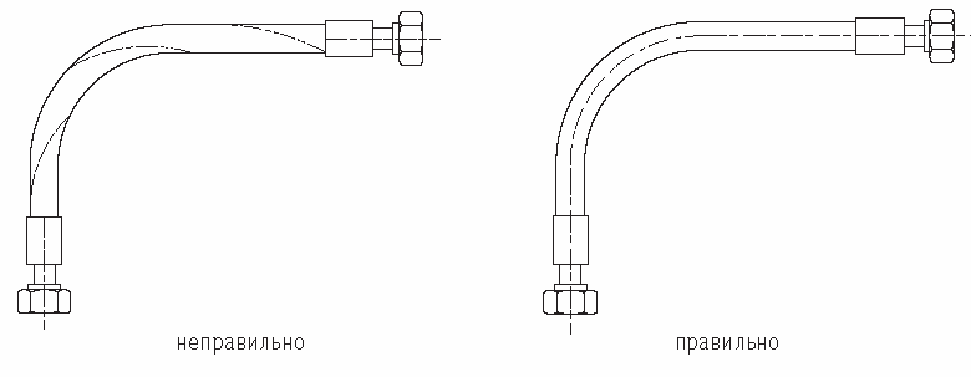 |
| During installation, make sure that the hose is not twisted when tightening the union nuts, for example! (hold it with a wrench if possible). |
• BENDING RADIUS LESS THAN MINIMUM |
If the bending radius of the hydraulic connection is smaller than the minimum allowed, the service life and the maximum permissible load will inevitably be reduced, because gaps in the overlap on the wire braid may occur at the outer bend due to the larger covering surface. This may lead to "oil leaks "
(see below).
For each type of hose, depending on the conditional passage, the permissible bending radius is determined. On the inside bend, the opposite effect appears:
the pressure carrier is flattened - does not fit tightly enough to the inner surface of the hose and therefore loses its characteristics of the pressure carrier.
A bend radius smaller than the minimum is most often - and often unnoticed - directly behind the connection point if the hose is bent too sharply.
|
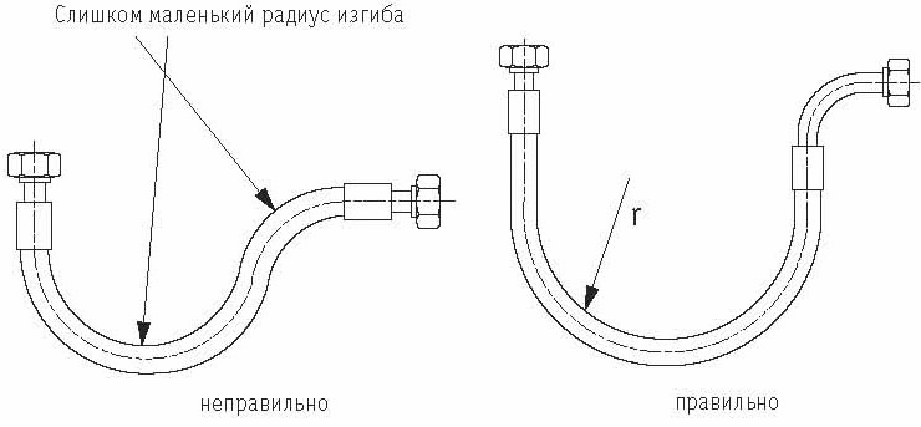 |
| The bending of the hose, if the installation conditions allow it, should start after a straight section, the length of which corresponds to 1.5 times the length of the outer diameter. If necessary, in such cases, protection against fracture or other means can be used. |
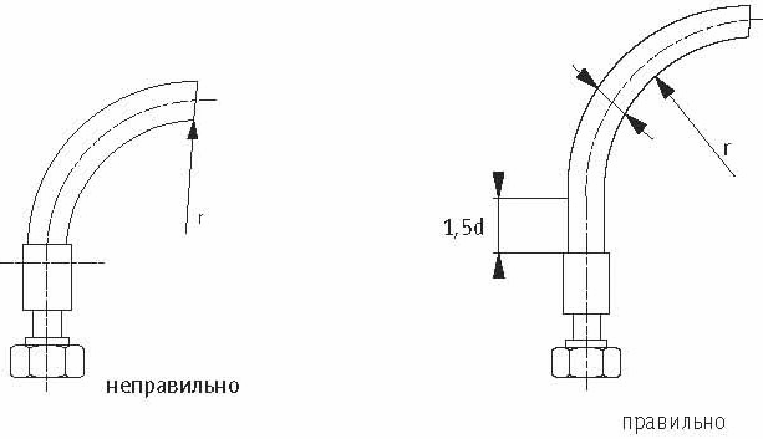 |
| In some cases, to avoid using a bend radius less than the minimum, use the selection of the appropriate reinforcement: |
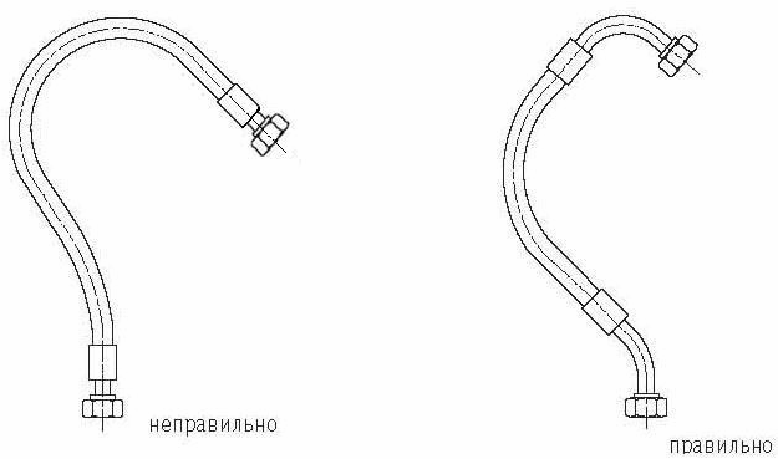 |
ATTENTION!
Oil leaks are thin jets that, under high pressure, penetrate outward through the walls of the hose. If such jets appear, the system must be switched off immediately, in no case should you come into contact with these oil jets!
Such a jet immediately penetrates human tissues and spreads there. Hydraulic fluids contain bacteria which, if injured, cause life-threatening blood poisoning! Due to their small size and high pressure, such wounds are often painless; If oil for hydraulic systems has penetrated into human tissues, you should immediately consult a doctor! |
• ABRASION |
If the hose is routed over an edge (rib), the surface of the hose may be chafed due to the movement of the hose itself. The same applies to hoses that are laid at an insufficient distance from each other: the hoses rub against each other.
Consequence: The wire braid is no longer protected against corrosion, hose failure is getting closer.
Already now there are hoses with an additional layer of polyvinyl chloride. Disadvantage: The bending radius becomes larger and the hoses become stiffer. When using hoses with a PVC layer, the effect of the softeners contained in the material must be taken into account. |
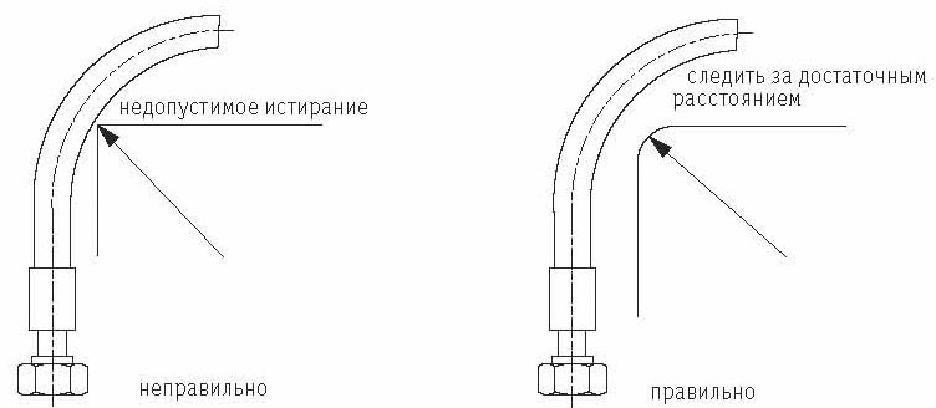 |
• TENSILE LOAD |
| Tensile stresses on the hoses must be avoided in any case, as this poses a threat to the reliable
fittings connection. Please note that pressurized hydraulic hoses can shorten slightly, so they must always be routed with a certain amount of slack, and possible movements must also be taken into account: |
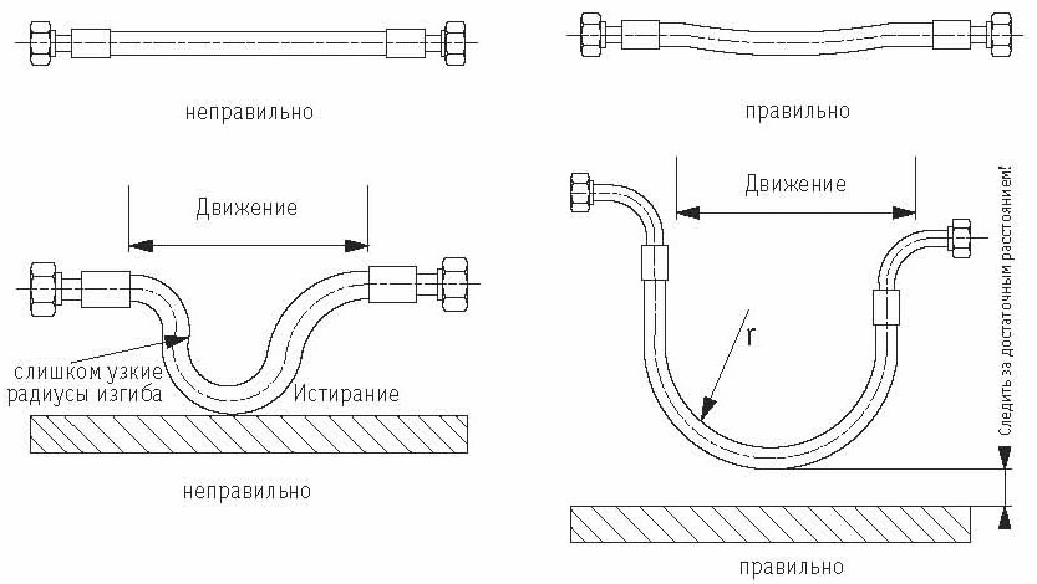 |
ATTENTION!
In certain cases, such as when using spring-loaded idlers, tensile loads cannot be avoided. In this case, the permissible operating loads must be agreed with the manufacturer. |
• HOSE FASTENING |
Avoid fixing hoses in places where it interferes with natural movement and changes in hose length:
Changing the direction of the pulsating oil flow causes pulsating movements of the arc of the left hose. The outer surface in the mount, which is subject to friction for a long time, is wiped off.
Hose fasteners should be installed, if possible, only on straight sections. When doing so, changes in hose diameter must be taken into account. |
 |
• HOSE RUPTURE |
It is possible to constructively prepare for the dangerous blowout of the hose when the hydraulic connection is broken. After installing the hydraulic hose, you can install:
1. casing
2. guide channels;
3. chain connections between the hose and the connection point.
Braided constructions are suitable for prudent installation, which are easily pulled together, ensuring a reliable connection of the hose to the machine parts. |
